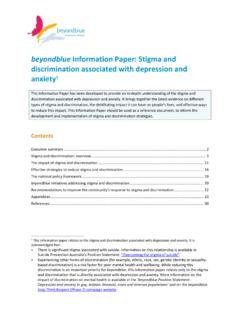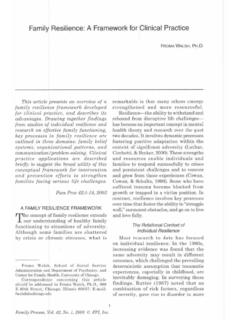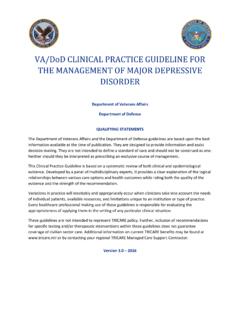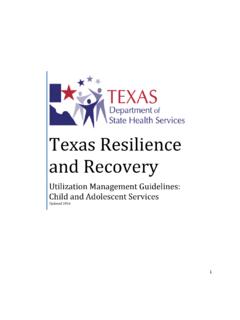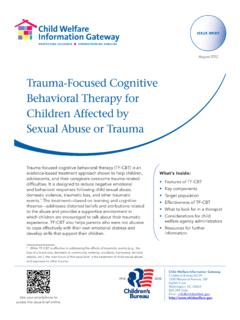Transcription of Good practice framework for mental health and wellbeing in ...
1 Good practice f ramework for mental health and wellbeing in police and emergency services organisationsBeyond Blue acknowledges the Traditional Custodians of the Land in Melbourne on which our head office is based, the Wurundjeri people of the Kulin Nation, and pay our respects to their Elders past and present. We also extend our respect to all Traditional Owners, and Aboriginal and Torres Strait Islander people across the diverse lands of our country, their Elders, cultures and heritages. We recognise the continuing connection that land and country has to the identity, strength and wellbeing of individuals, families and first version of the Good practice framework for mental health and wellbeing in first responder organisations was developed by Beyond Blue in 2016. This revised f ramework has been developed f rom further insights gained during the Beyond Blue Police and Emergency Services Program original f ramework was developed collaboratively, with input f rom small and large police and emergency services agencies in several states and territories.
2 A steering group of representatives f rom Australian front line agencies in police, ambulance, fire and rescue and state emergency services was invaluable. A number of people with f ront line operational, union, legal, clinical and academic expertise also provided input into the f ramework. These included Blue Voices members with experience working in police and emergency services roles. Blue Voices is Beyond Blue s community of people who have personal experience of anxiety, depression and/or Blue engaged the FBG Group to lead the consultation on, and development of, the 2016 Good practice f ramework. Since then, in collaboration with the police and emergency services sector, Beyond Blue has undertaken an extensive three-phase national study of the mental health of police and emergency services workers. A summary of the study can be found here.
3 In 2019 Beyond Blue commissioned FBG Group to undertake the third and final stage of the study which involved working with 33 participating agencies to translate knowledge from the first two phases into practical actions for their organisation. This revised version of the Good practice f ramework incorporates learnings f rom across the three phases of the national study. We would like to thank the 33 police and emergency services agencies for their participation in this of the images in this document have been provided by Victoria State Emergency Service and Ambulance would like to thank everyone involved for their valuable Blue is especially grateful to all current and former police and emergency services personnel who shared the stories of their personal mental health experiences with the purpose of this document, Beyond Blue has defined police and emergency services organisations to include: Ambulance services Fire and rescue services Police forces State emergency services (SES).
4 ContentsPurpose of this document 4 Introduction 5 mental health and suicide 7 Understanding mental health 7 Understanding suicide 8 mental health and the workplace 9An integrated approach to mental health and wellbeing 10 mental health in the police and emergency services setting 11 The mental health of police and emergency services personnel 11 Preventing suicide in police and emergency services personnel 11 The police and emergency services personnel s career 12 Volunteers and rural police and emergency services personnel 12 Non-operational workers 13 The role of family and social supports 13 Good practice model for mental health and wellbeing in police 14 and emergency services organisationsKey principles of good practice 15 Shared responsibility 15 Modifying risk and protective factors 15 Strengths-based culture 15 Integrated, holistic approach 15 Commitment to continuous improvement 16 Core areas of action 17 Promoting mental health and wellbeing across the police and 28 emergency services personnel s careerRecruitment 28 Operational service 30 Leaving the service and post-service 42 Next steps what can you do?
5 43 Glossary of terms 44 Resources 46 For police and emergency services personnel 46 For organisations 47 References 484 Purpose of this documentThis document provides police and emergency services organisations with an evidence-informed f ramework that provides guidance to protect the mental health of their workforces, promote wellbeing and prevent suicide. This second version of the Good practice f ramework incorporates learnings and insights f rom across the three phases of the Police and Emergency Services National Study police and emergency services agency, just like every workplace, has unique characteristics.
6 This f ramework is not intended to be prescriptive. However, there are common, core actions that work, and issues that every agency can and needs to f ramework: encourages a strategic and integrated approach to mental health offers an evidence-based framework of preventative measures, as well as supportive interventions for police and emergency services personnel in the field emphasises a positive approach to mental health , by encouraging organisations to actively promote wellbeing as a core part of business highlights the need for shared responsibility identifies key principles for creating mentally healthy workplaces that are high performing and enable each police and emergency services personnel to achieve their best provides practical guidance on how to develop or check an existing strategy to promote the mental health and wellbeing of a police and emergency services workforce presents a comprehensive set of actions across the police and emergency services personnel s career to assist each organisation to examine their approach to mental health and wellbeing offers guidance about support that can be provided to police and emergency services personnel who develop a mental health condition gives
7 Practical suggestions about how to use this workplace has a responsibility to ensure that the mental health of their workers is protected, promoted and supported. This responsibility is heightened for police and emergency services organisations, given their unique and often challenging work nature of emergency services work means police and emergency services personnel are likely to be regularly exposed to potentially traumatic events, which may or may not impact their mental health . Like other workers, they may also experience common workplace stressors, such as excessive workloads, inadequate support and the call Beyond Blue s National mental health and wellbeing Study of Police and Emergency Services found that police and emergency services workers are more than twice as likely to experience high or very high rates of psychological distress compared to the general , it found many employees and volunteers have good mental health and wellbeing with more than half of all employees and two in three volunteers reporting high levels of resilience.
8 However, employees who had worked more than 10 years were almost twice as likely to experience psychological distress and were six times more likely to experience symptoms of post-traumatic stress disorder (PTSD).2 That is why a key recommendation f rom the study was for each police and emergency service agency to develop an organisational mental health and wellbeing productive and making a contribution not only protects mental health , but also helps with recovery f rom a mental health culture plays a significant role in how workers respond to challenges whether they relate to the workplace or life outside of it. There are many protective cultural and other factors in police and emergency services that have a positive impact on wellbeing . For example, there is often a strong sense of community and camaraderie in police and emergency services environments.
9 Workers are spending more time at work than ever are also elements of culture that present a risk to mental health and wellbeing . Stigma, and potentially discrimination, regarding mental health conditions is still prevalent. Many people still worry about talking about suicide and lack the confidence to approach someone about it because they are af raid of doing harm or saying the wrong thing. In many police and emergency services organisations, there are concerns about the confidentiality of support services as they may be perceived to be linked to line management, career development and performance management. These concerns may deter workers f rom seeking help for mental health difficulties and remain significant barriers to promoting mental these barriers is an ongoing journey requiring a cultural shift.
10 This will only be achieved if everyone in an organisation is committed to working together to improve mental health and wellbeing and prevent qualities and skills also play a role in how people respond to stressful situations, at work or in their personal lives. Most police and emergency services personnel manage the challenges of the job well, and have the ability to withstand, adapt to, and recover f rom the stress and adversity associated with their role. Yet even the most resilient people can be impacted by conf ronting situations or poor workplace cultures. For example, there is evidence that repeated exposure to critical incidents can have a cumulative impact on a As a result, mental health is a shared responsibility for all people, at all levels, in the workplace. Police and emergency services personnel have a responsibility to look after their own mental health and develop a range of skills to build resilience and cope with the demands of the job.
